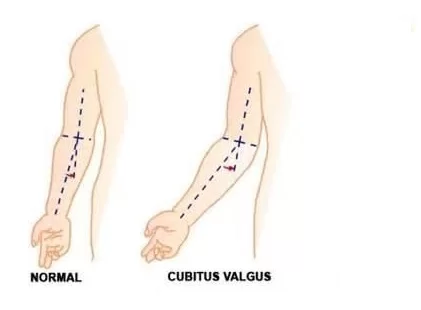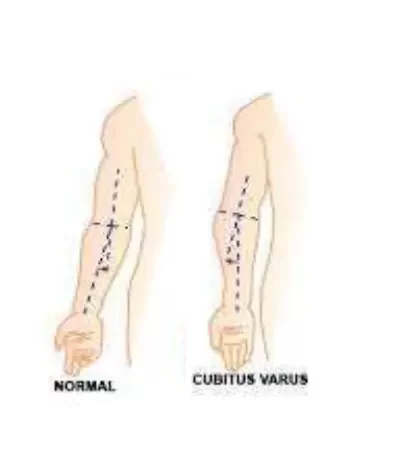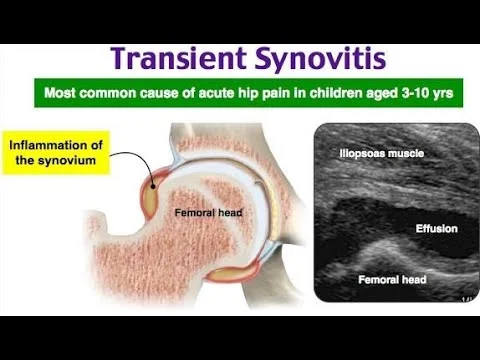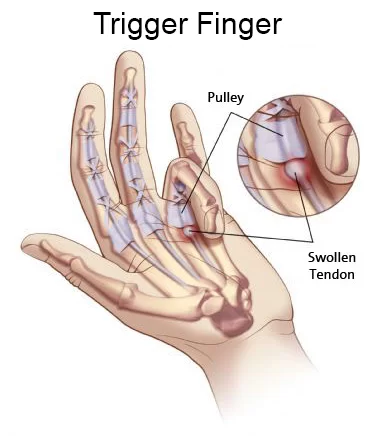Cubitus Valgus Deformity
What is a Cubitus Valgus?
Cubitus valgus is a deformity in which the forearm is angled out away from the body when the arm is fully extended.
When your palm is facing upward and your arm is extended, you may have cubitus valgus if your carrying angle, or the degree to which your arm is angling away from your body, exceeds 15 degrees.
However, it’s possible to be diagnosed with cubitus valgus with a carrying angle of anywhere between 3 and 29 degrees. The angle is often more pronounced in women.
This condition doesn’t always need to be treated, but in some people, it can compress the nerves in the arm, causing complications.
Causes to Develop Cubitus Valgus
There are two possible causes for cubitus valgus:
- A congenital condition
- A Fractures
A Fractures
- Post-traumatic malunited humerus fracture (most common)
- Malunited fracture lateral condyle
- Trochlear osteonecrosis (static)
- Malunited intercondylar fracture (static)
- Malunited medial condyle fracture (static)
A Congenital Condition
The two congenital conditions that commonly cause cubitus valgus are
- Turner syndrome
- Noonan syndrome.
Turner syndrome is a chromosomal disorder in which a female is born with only one X chromosome. People with Turner syndrome experience a number of other symptoms, including short stature and delayed puberty. Treatment usually involves hormone replacement therapy.
Noonan syndrome is another genetic disorder that results in delayed development. It’s usually caused by a genetic mutation, but sometimes doctors aren’t sure why it develops. While there’s no cure for Noonan syndrome, there are a number of treatments that can help minimize its effects.
Types of Cubitus Valgus
- Static (non-progressive)
- Progressive
ON EXAMINATION
Inspection
- Hyperextension Deformity
- Limited Flexion
- Lateral tilt and Medial angulation at the elbow joint.
- Wasting of muscles
- The prominence of the Medial condyle humerus
Palpation
- Tenderness
- Thickening and irregularity of supracondylar ridges
- Lateral epicondyle tip higher
- Internal rotation deformity with increased internal rotation (Yamamoto test)
- Decrease external rotation which is compensated by much more mobile shoulder joint
Complications of Cubitus Valgus
Cubitus valgus is a known cause of ulnar neuropathy. This is a disorder involving the ulnar nerve, which is one of the three main nerves in your arm.
Ulnar neuropathy most often occurs when the ulnar nerve becomes compressed or irritated, causing numbness, tingling, and occasionally weakness. Most of the time treatment involves limiting physical activity and wearing a brace. However, if these conservative treatments don’t work, surgery may be necessary.
Cubitus valgus can also lead to a condition called tardy ulnar nerve palsy, a type of ulnar neuropathy. This is a chronic condition that is commonly associated with cubitus valgus.
Ulnar nerve palsy is progressive, in that it usually gets worse over time. You may experience a loss of sensation in your fingers, especially your ring and little finger, as well as loss of coordination, tingling and burning, pain, and weakness.
There are a number of treatments for the symptoms of ulnar nerve palsy, including over-the-counter medications and physiotherapy.
Treatment of Cubitus Valgus
If cubitus valgus isn’t compressing your ulnar nerve, you probably won’t need treatment.
Corrective stretching and Strengthening of weak muscles and Joint mobilization exercises are helpful to some extent with the help of an elbow splint.
Physiotherapy Treatment
- Hot fermentation can be used to ease joint stiffness and pain.
- Gentle soft tissue release can be done in the arm and forearm musculature.
- Gentle active and active-assisted exercises using a wand and be taught in pain-free limit- frequently in a day.
- Isometric exercises for arm and forearm musculature can be addressed.
- Avoid weight lifting.
- Corrective Splint
Surgical Treatment
In most cases, cubitus valgus is treated by one of two procedures:
osteotomy or fixation
Osteotomy is a process in which your doctor cuts the bone in order to reshape it, thereby changing its alignment.
A particular type of osteotomy called distraction osteogenesis has been used to treat cubitus valgus in children. This operation works by making a longer bone out of a shorter one. The bone that is cut during surgery is pulled apart using a device called a distractor, a process that is only mildly painful. New bone will grow in the gap created by the distractor, creating a long bone in place of a shorter one.
Fixation is the process by which your doctor will reconnect the bones of the elbow, usually following a fracture.
FAQs
Can you fix cubitus valgus?
The most frequent side effect of lateral condylar fractures is cubitus valgus. The correction of valgus deformity has been explained through a variety of osteotomy and fixation combinations.
Is cubitus valgus normal?
Cubitus valgus is a condition of the elbow in which the forearm is inclined away from the body when the elbow is fully straight. Cubitus valgus also referred to as the carrying angle, can be tolerated in small amounts and is common.
Is cubitus varus curable?
Corrective Osteotomy surgery: The only treatment option for cubitus varus deformity that has a high chance of success is osteotomy.








One Comment